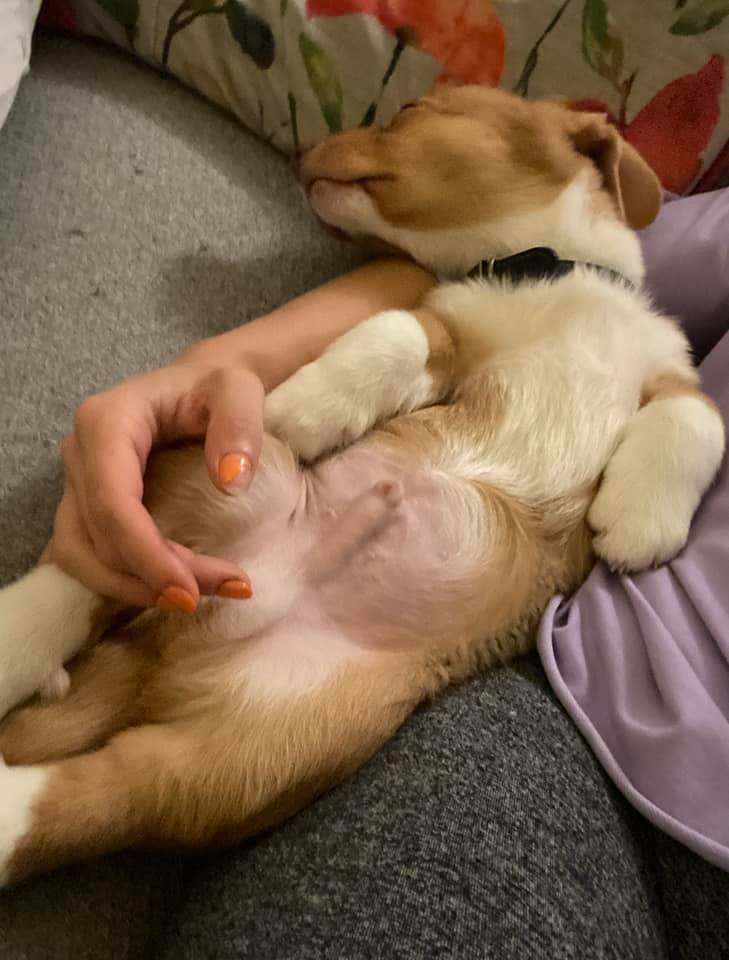The force-free way to a happy, confident pup, and a great relationship
By Sally Bradbury
There are four steps to a harmonious relationship:
- Prevent
- Reinforce
- Teach
- Interrupt Positively

Prevent
Prevent what you can wherever possible and manage the pup’s environment so that he has little or no opportunity to go wrong. This means puppy-proofing the house and includes moving books from the lower shelves on the bookshelves (I had to relocate the bottles in the wine rack in the kitchen when my pup was younger!!), putting bins behind cupboard doors, picking up all Persian rugs temporarily, using stair gates, and closing doors to prevent access to areas where the pup may chew precious furnishings. Most importantly, it involves putting things away, such as shoes and children’s toys.
Any time your dog engages in an unwanted behaviour, take a step back
and ask yourself how you could have prevented it.
Reinforce
Reinforce your pup for offering behaviours that are agreeable. This can
even be the absence of an unwanted behaviour. The best way to do this
is to have a pot of small, yummy treats, such as hot dog sausage, liver, or
cheese, say 30 in number, and set yourself a challenge to catch your dog
doing something that you like, and would like him to do again, 30 times
during the day. It could be lying in his bed, choosing to keep his front feet on the floor when a visitor comes in, coming in from the garden, chewing his chew toy; the possibilities are endless (think I nicked that from an advert). To start with, you may struggle to find 30 opportunities. However, as dogs do what works for them, you will soon need more treats in that pot because your dog is going to be throwing these behaviours at you left, right and centre. These are behaviours that you haven’t asked for, by the way, and this is by far the easiest way for a dog to learn.
Teach
Teach your dog what you would like him to do. The obvious things are to
walk nicely on a lead, come when called, sit, lie down, and stay. There are many ways to teach your dog, but it is important that whatever method you choose, it is easy to understand and fair to the dog. Think back to how you learned in school. I bet your favourite subject was the one where the teacher made it fun and enjoyable to learn and motivated you with praise and rewards for good work. I tend to teach all of my dogs during play, so lots of fetch and tug games used as rewards and the dog is having a ton of fun while learning.
Interrupt Unwanted Behaviour
I know from experience that it is not always possible to prevent all
unwanted behaviours when you have a puppy.
It is very difficult not to get cross when your pup chews your smartphone
or expensive shoes; it is human nature. However, in terms of your
relationship with your dog and ensuring that the behaviour doesn’t
continue into adulthood, you really do have to take a deep breath and try
not to scowl. The damage is done, and nothing will undo it now.
So, you teach your dog a positive interrupter. This can be a word or a
noise, anything you like, as long as it doesn’t frighten or startle your pup.
My pup’s positive interrupter is ‘Moss’ said in a happy voice. I can use his
name because I have never said it crossly or to tell him off. You could use
a ‘Yay!!’ or a kissy noise for example. All you do is use food treats, you can
move to a toy later, and say the word as you give him a treat. Repeat a few hundred times. Yes, really! Now watch his response to that word next time you say it when he is doing something you would like to interrupt. Once interrupted redirect him onto something more productive.
If you interrupt unwanted behaviours in a way that frightens your dog, he
will simply learn that these behaviours are dangerous to do when you are
present and will seek opportunities to engage in them when your back is
turned. And yes, the dog could learn to engage in the behaviours in order
to be positively interrupted, BUT he will only do it when you are watching.
No point when you are not, so now you can interrupt before the damage
is done. Meanwhile, teach the dog a more rewarding behaviour instead.
Think of your relationship with your puppy as a bank account. Every
positive interaction is a deposit; every time you punish you make a
withdrawal. As soon as your account becomes overdrawn, then things will
just go from bad to worse. Keep a nice healthy bank balance and you and
you pup will soon end up as millionaires in the relationship stakes.

